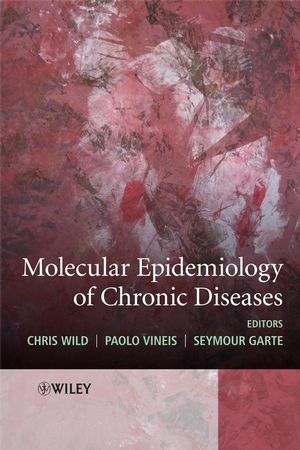
Molecular Epidemiology of Chronic Diseases
John Wiley & Sons Inc (Verlag)
978-0-470-02743-1 (ISBN)
"I think this is an excellent book–I recommend it to anyone involved in molecular epidemiology... The 26 chapters are written by topic specialists, in an explanatory, east to read style." –BTS Newsletter, Summer 2009 "This text provides an accessible and useful handbook for the epidemiologist who wants to survey the field, to become better informed, to look at recent developments and get some background on these or simply to appreciate further the relatively rapid changes in informatic and analytical technologies which increasingly will serve and underpin future epidemiological studies. One of the strengths in this book is the extensive array of practical illustrative examples, and it would also in my opinion have useful potential as a teaching text." –American Journal of Human Biology, March 2009
With the sequencing of the human genome and the mapping of millions of single nucleotide polymorphisms, epidemiology has moved into the molecular domain. Scientists can now use molecular markers to track disease-associated genes in populations, enabling them to study complex chronic diseases that might result from the weak interactions of many genes with the environment. Use of these laboratory generated biomarker data and an understanding of disease mechanisms are increasingly important in elucidating disease aetiology.
Molecular Epidemiology of Disease crosses the disciplinary boundaries between laboratory scientists, epidemiologists, clinical researchers and biostatisticians and is accessible to all these relevant research communities in focusing on practical issues of application, rather than reviews of current areas of research.
Covers categories of biomarkers of exposure, susceptibility and disease
Includes chapters on novel technologies: genomics, transcriptomics, proteomics and metabonomics, which are increasingly finding application in population studies
Emphasizes new statistical and bioinformatics approaches necessitated by the large data sets generated using these new methodologies
Demonstrates the potential applications of laboratory techniques in tackling epidemiological problems while considering their limitations, including the sources of uncertainty and inaccuracy
Discusses issues such as reliability (compared to traditional epidemiological methods) and the timing of exposure
Explores practical elements of conducting population studies, including biological repositories and ethics
Molecular Epidemiology of Disease provides an easy-to-use, clearly presented handbook that allows epidemiologists to understand the specifics of research involving biomarkers, and laboratory scientists to understand the main issues of epidemiological study design and analysis. It also provides a useful tool for courses on molecular epidemiology, using many examples from population studies to illustrate key concepts and principles.
Professor Chris Wild. Molecular Epidemiology Unit, Head, Centre for Epidemiology and Biostatistics, Faculty of Medicine and Health, The LIGHT Laboratories, University of Leeds, UK. Professor Paolo Vineis. Chair in Environmental Epidemiology, Div of Primary Care and Population Health Sciences, Medicine, Imperial College, London, UK. Professor Seymour Garte. Professor of Environmental and Community Medicine, Robert Wood Johnson Medical School, University of Medicine and Dentistry of New Jersey; Scientific Director, Genetics Research Institute, Milan, Italy. Center for Environmental Oncology, University of Pittsburgh Cancer Institute, Pittsburgh,?PA,?USA.
Contributors. Acknowledgements.
1. Introduction: why molecular epidemiology? (Chris Wild, Seymour Garte and Paolo Vineis).
2. Study design (Paolo Vineis).
3. Molecular epidemiological studies that can be nested within cohorts (Andrew Rundle and Habibul Ahsan).
4. Family studies, haplotypes and gene association studies (Jennifer H. Barrett, D. Timothy Bishop and Mark M. Iles).
5. Individual susceptibility and gene-environment interaction (Seymour Garte).
6. Biomarker validation (Paolo Vineis and Seymour Garte).
7. Exposure assessment (Mark J. Nieuwenhuijsen).
8. Carcinogen metabolites as biomarkers (Stephen S. Hecht).
9. Biomarkers of exposure: adducts (David H. Phillips).
10. Biomarkers of mutation and DNA repair capacity (Marianne Berwick and Richard J. Albertini).
11. High-throughput techniques -genotyping and genomics (Alison M. Dunning and Craig Luccarini).
12. Proteomics and molecular epidemiology (Jeff N. Keen and John B.C. Findlay).
13. Exploring the contribution of metabolic profiling to epidemiological studies (M. Bictash, Elaine Holmes, H. Keun, P. Elliott and J. K. Nicholson).
14. Univariate and multivariate data analysis (Yu-Kang Tu and Mark S. Gilthorpe).
15. Meta-analysis and pooled analysis - genetic and environmental data (Camille Ragin and Emanuela Taioli).
16. Analysis of Complex datasets (Jason H. Moore, Margaret R. Karagas and Angeline S. Andrew).
17. Some implications of random exposure measurement errors in occupational and environmental epidemiology (S. M. Rappaport and L . L. Kupper).
18. Bioinformatics (Jason H. Moore).
19. Biomarkers, disease mechanisms and their role in regulatory decisions (Pier Alberto Bertazzi and Antonio Mutti).
20. Biomarkers as endpoints in intervention studies (Lynnette R. Ferguson).
21. Biological resource centres in molecular epidemiology: collecting, storing and analysing biospecimens (Elodie Caboux, Pierre Hainaut and Emmanuelle Gormally).
22. Molecular epidemiogy and ethics: biomarkers for disease susceptibility (Kirsi Vähäkangas).
23. Biomarkers for dietary carcinogens: the example of heterocyclic amines in epidemiological studies (Rashmi Sinha, Amanda Cross and Robert J. Turesky).
24. Practical examples: hormones (Sabina Rinaldi and Rudolf Kaaks).
25. Aflatoxin, hepatitis B virus and liver cancer: a paradigm for molecular epidemiology (John D. Gropman,Thomas. W. Kensler and Chris Wild).
26. Complex exposures - air pollution (Steffen Loft, Elvira Vaclavik Brauner, Lykke Forchhammer, Marie Pedersen, Lisbeth E. Knudsen and Peter Moller).
Index.
| Erscheint lt. Verlag | 1.5.2008 |
|---|---|
| Verlagsort | New York |
| Sprache | englisch |
| Maße | 195 x 250 mm |
| Gewicht | 975 g |
| Themenwelt | Studium ► Querschnittsbereiche ► Epidemiologie / Med. Biometrie |
| Naturwissenschaften ► Biologie ► Genetik / Molekularbiologie | |
| ISBN-10 | 0-470-02743-6 / 0470027436 |
| ISBN-13 | 978-0-470-02743-1 / 9780470027431 |
| Zustand | Neuware |
| Haben Sie eine Frage zum Produkt? |
aus dem Bereich


